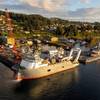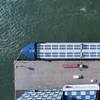Development on BWM highlights - IMO's R&D Forum
Ballast water management experts, meeting at the recent IMO-GloBallast R&D Forum in Canada, have showcased the latest developments in ballast water management and highlighted the areas where further research is needed, in order to prevent the spread of potentially harmful species in ballast water.
Some 140 participants from IMO Member States, academia, private sector, testing facilities and the maritime technology industry were meeting at the International Civil Aviation Organization (ICAO) in Montreal, Canada, for the 6th Global Environment Facility (GEF)-United Nations Development Program (UNDP)-IMO GloBallast R&D Forum and Exhibition on Ballast Water Management (16-18 March 2016), under the banner “Ballast Water Management Convention – moving towards implementation”.
IMO’s International Convention for the Control and Management of Ships' Ballast Water and Sediments is very close to reaching its entry into force criteria. The convention will require ships to manage their ballast water so that any aquatic organisms and pathogens are removed or rendered harmless before the ballast water is released into a new location.
The participants highlighted the need for further research, in particularly for compliance and monitoring, alternative treatment methods and risk assessment based decision support tools.
Mr Marc Garneau, Minister of Transport of Canada, opened the Forum. IMO’s Stefan Micallef, Director, Marine Environment Division, stated in his opening remarks that the Ballast Water Management Convention needed to enter into force for effective implementation of its provisions and urged IMO Member States to ratify the Convention. He also highlighted the huge amount of collaborative work which had been undertaken since the first GEF-UNDP-IMO GloBallast R&D Forum 15 years ago, leading to a great deal of progress in the ballast water management field in terms of testing and approval of ballast water management systems, ballast water sampling and analysis, and the availability of ballast water management systems.
Responding to shipowner concerns about the reliability of available ballast water management treatment systems, the Forum held a session on alternative treatment methods, a sector which has seen significant development since the last R&D Forum held in Busan, Republic of Korea, in 2013. During a dedicated session, participants were informed about available solutions, including port-based contingency measures, mobile treatment solutions and ballast water management treatment boats. Mobile treatment solutions include those on barges or small boats, which can plug into the ship for example when the ballast water management system installed is not functioning or has broken down. This could offer shipowners the flexibility and reliability they are looking for.
The R&D Forum heard the perspective of the shipping industry during the IMO-IMarEST Shipping Industry Forum session, including the views of many shipowners and private sector representatives from Canada.
The GloBallast partner from the private sector, APL, Singapore, a member of the Global Industry Alliance (GIA) showcased its proactive approach under which it has installed ballast water treatment technology on most APL ships. APL encouraged other shipowners to install ballast water management treatment systems on board ships before the Ballast Water Management Convention enters into force, to allow sufficient time for a proper system installation. A number of other private sector representatives shared this proactive approach.
The Forum also saw presentations from class societies (including the International Association of Classification Societies (IACS), ABS, DNV-GL, KR and IR-Class).
The views of three of the GloBallast Lead Partnering and Pilot countries (Turkey, Chile, Brazil) were presented in a special policy session, giving the Forum a truly global vision of the status of implementation of the Ballast Water Management Convention by all the main stakeholders in this field.
Discussions on risk assessment for exemptions and ship targeting for port State control officers, also took place. Port State control officers will be at the front line of monitoring compliance with the Ballast Water Management Convention once it enters into force. It was noted that while research still needs to be undertaken, several tools already exist to support port State control monitoring and other are in the pipeline. In particular, participants highlighted a need for the development of risk assessment based decision support tools for port State control officers.
The discussions during the R&D Forum are expected to play a catalytic role in the development of such new tools, from port-based measures to risk assessment software.
The Forum ended by opening the topic of discussion to the other main vector for the transfer of marine invasive aquatic species via ships, namely through biofouling, the undesirable accumulation of microorganisms, plants, algae and animals on submerged structures (especially ships’ hulls). IMO has adopted Guidelines for the control and management of ships' biofouling to minimize the transfer of invasive aquatic species.









